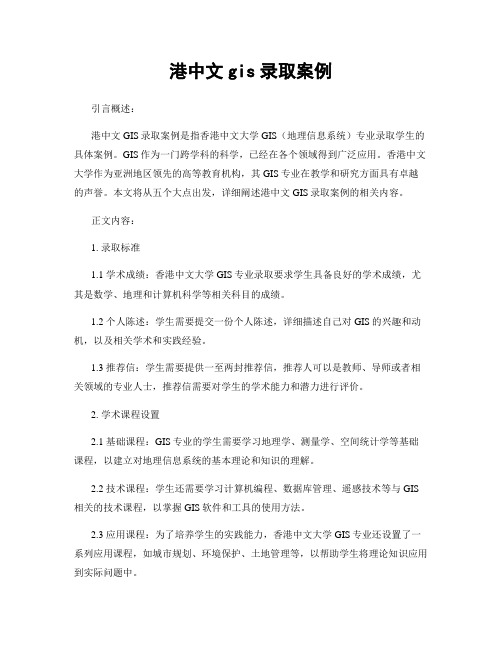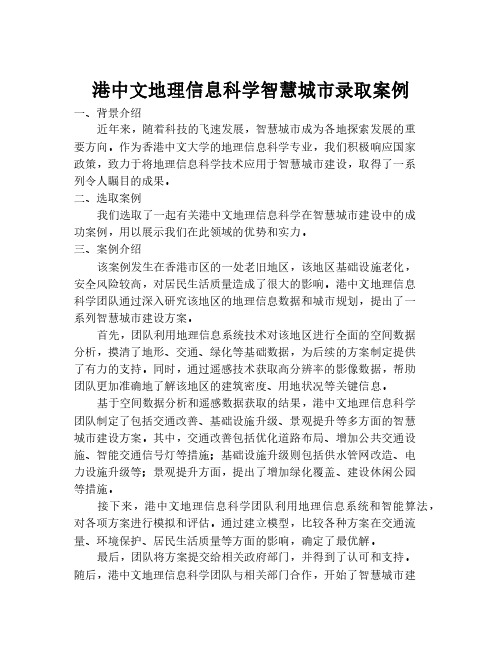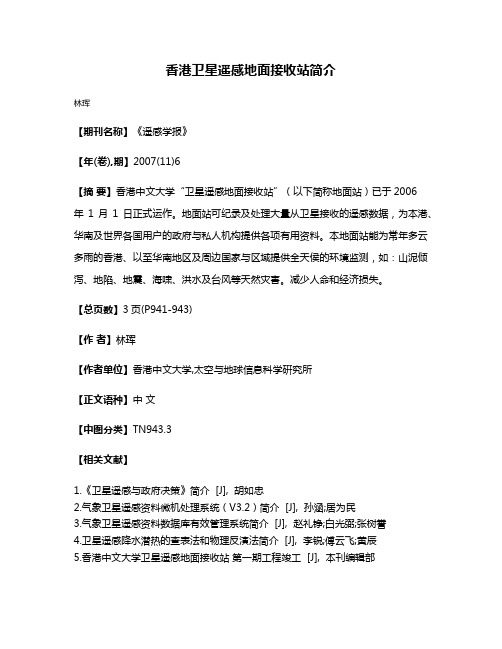香港中文大学卫星遥感地面接收站-CUHK
港中文gis录取案例

港中文gis录取案例引言概述:港中文GIS录取案例是指香港中文大学GIS(地理信息系统)专业录取学生的具体案例。
GIS作为一门跨学科的科学,已经在各个领域得到广泛应用。
香港中文大学作为亚洲地区领先的高等教育机构,其GIS专业在教学和研究方面具有卓越的声誉。
本文将从五个大点出发,详细阐述港中文GIS录取案例的相关内容。
正文内容:1. 录取标准1.1 学术成绩:香港中文大学GIS专业录取要求学生具备良好的学术成绩,尤其是数学、地理和计算机科学等相关科目的成绩。
1.2 个人陈述:学生需要提交一份个人陈述,详细描述自己对GIS的兴趣和动机,以及相关学术和实践经验。
1.3 推荐信:学生需要提供一至两封推荐信,推荐人可以是教师、导师或者相关领域的专业人士,推荐信需要对学生的学术能力和潜力进行评价。
2. 学术课程设置2.1 基础课程:GIS专业的学生需要学习地理学、测量学、空间统计学等基础课程,以建立对地理信息系统的基本理论和知识的理解。
2.2 技术课程:学生还需要学习计算机编程、数据库管理、遥感技术等与GIS 相关的技术课程,以掌握GIS软件和工具的使用方法。
2.3 应用课程:为了培养学生的实践能力,香港中文大学GIS专业还设置了一系列应用课程,如城市规划、环境保护、土地管理等,以帮助学生将理论知识应用到实际问题中。
3. 实践机会3.1 实习项目:香港中文大学GIS专业为学生提供了丰富的实习项目,学生可以在实际项目中应用所学的GIS知识和技术,提高自己的实践能力。
3.2 研究机会:学生还可以参与教师的研究项目,与教师一起进行科研工作,深入了解GIS领域的最新发展和研究方向。
3.3 校外合作:香港中文大学GIS专业与各个领域的机构和企业有广泛的合作关系,学生可以通过校外合作项目,与实际应用场景接触,提升自己的综合素质。
4. 学术活动4.1 学术讲座:香港中文大学GIS专业经常举办学术讲座,邀请国内外的专家学者来校交流和分享最新的GIS研究成果。
征集各大高校IPv6网站地址,看看有你学校没

/注册登录IPv6论坛IPv6主站IPv6镜像IPv6资源家园服务百科地址查询在线代理电视直播软件下载网址之家默认风格Water(水)私人消息(0)公共消息(0)系统消息(0)好友消息(0)帖子消息(0)应用通知(0)应用邀请(0)IPv6之家» IPv6资源»征集各大高校IPv6网站地址,看看有你学校没?(20101031更新)12345678910... 16下一页返回列表发帖admin 发短消息加为好友admin (乱世狂人)当前离线UID1 帖子5989 精华4 积分5077 金钱11993 V币阅读权限200 在线时间5027 小时注册时间2008-11-17 最后登录2012-7-22管理员UID1 帖子5989 精华 4 积分5077 金钱11993 V币在线时间5027 小时注册时间2008-11-17 最后登录2012-7-22 1# 跳转到»倒序看帖打印字体大小: tT 发表于2009-4-8 11:07 | 只看该作者[活动] 征集各大高校IPv6网站地址,看看有你学校没?(20101031更新)台湾院校澳门院校香港院校香港中文大学/ [2405:3000:3:c02:137:189:192:35]新疆院校宁夏院校青海院校甘肃院校兰州大学/ [2001:da8:c000::200]陕西院校陕西科技大学/陕西师范大学/ [2001:da8:4001:1::2]西北大学/西安交通大学/第四军医大学/长安大学/ /西北工业大学/西安电子科技大学/西安理工大学/西北农林科技大学/西安建筑科技大学/西安邮电学院/西藏院校云南院校云南大学/贵州院校贵州师范大学/贵州大学/四川院校四川大学/成都医学院/西南交通大学/电子科技大学/成都理工大学/西南财经大学http://西南民族大学/成都信息工程学院/西华大学/重庆院校重庆师范大学/西南大学/重庆大学/海南院校广西院校广东院校华南农业大学/广东技术师范学院/ [2001:da8:2006::2]华南师范大学/华南理工大学/ [2001:da8:2000:2017::110] 汕头大学/湛江机电学校/ipv6/暨南大学/深圳大学/ [2001:250:3c00:3::164]中山大学/湖南院校中南大学/湖南大学/湖南师范大学/hnsd/长沙理工大学/国防科技大学/湖北院校武汉大学/华中科技大学/荆楚理工学院/武汉纺织大学/河南院校河南大学/郑州大学/ /平顶山学院/河南理工大学/周口师范学院/河南科技学院/山东院校山东理工大学/济南大学/山东农业大学/ /山东大学/ [2001:da8:7000:40::246]中国石油大学(华东) /中国海洋大学/江西院校南昌大学/福建院校厦门大学/福建农林大学/集美大学/ [2001:250:6801:8802:210:34:128:137] 福州大学/安徽院校中国科学技术大学/安徽大学/ /合肥工业大学/安徽建筑工业学院/阜阳师范学院/滁州学院/浙江院校浙江大学/浙江财经学院/浙江工业大学/浙江大学城市学院/浙江工商大学/江苏院校苏州大学/东南大学/ /南京农业大学/ [2001:da8:1005:1000::80] 江苏工业大学/江苏工业学院/南京师范大学/南京航天航空大学/南京大学/南京理工大学/上海院校上海大学/复旦大学/同济大学/上海理工大学/上海电力学院/上海交通大学/上海师范大学/华东理工大学/东华大学/华东师范大学/上海财经大学/上海第二军医大学/上海外国语大学/上海水产大学/黑龙江院校东北农业大学/哈尔滨工程大学/哈尔滨工业大学/吉林院校东北电力大学/吉林大学/长春工业大学/长春师范学院/辽宁院校东北财经大学/大连海事大学/大连理工大学/ [2001:da8:a800:0:2d0:b7ff:feb8:4557] 沈阳航空工业学校/中国医科大学/辽宁大学/东北大学/内蒙古院校内蒙古大学/内蒙古师范大学/山西院校中北大学/太原理工大学/北京院校北京化工大学/中国农业大学/北京邮电大学/北京航空航天大学/中国传媒大学/北京科技大学/ [2001:da8:208:10::14]北京大学/中央民族大学/北京林业大学/北京师范大学/ipv6/北京交通大学/清华大学/北京工业大学/北京城市学院/中央音乐学院/中国青年政治学院/华北电力大学/天津院校天津大学/ipv6天津医科大学/河北院校河北大学/华北科技学院/华北电力大学(保定) :8080/以上信息来源于IPv6网址之家:/s/1008.html,转帖请注明出处。
【转】测绘行业网站集锦

【转】测绘行业网站集锦测绘网 青岛勘察测绘研究院安徽两淮地质基础工程公司第一工程处 傲腾通信(上海)科技有限公司 北京安彩星通科技有限公司 北京北大天创信息技术有限公司 北京北斗星通卫星导航技术公司 北京长征航信卫星技术导航有限公司 北京长征宇通测控通信技术公司 北京超图 北京超图地理信息系统有限公司 北京潮夕科技有限公司 北京城建勘测绘院 北京城市空间数据科技有限公司 北京德林信和科技有限公司 北京东方道亨科技发展有限公司 北京丰创GPS信息网 北京丰瑞宜科技发展有限公司 北京合众思壮科技有限责任公司 北京恒田嘉业商贸有限公司 北京慧立阳科技有限公司 北京慧图信息科技开发有限公司 北京吉威数源软件开发有限公司 北京金耐威科技发展 北京科瑞讯科技发展公司 北京利讯公司 北京励精思仪器技术有限公司 北京联合欣华科技发展有限公司 北京灵图软件技术有限公司 北京诺瓦信息技术有限公司 北京市测绘设计研究院 北京市遥感信息研究所 北京天测卫通科技发展有限公司 北京天拓基业科技发展公司 北京天行九洲通讯导航技术公司 北京天一指航科技有限公司 北京天之华软件系统技术在限责任公司 北京威远图公司 北京卫信杰科发展有限公司 北京星航联科技有限公司 北京星网迅达科技发展有限公司 北京中地超图 北京中翰仪器有限公司 蓓蓓的GIS小站 宾得维修中心 冰洋驿站 测绘科学 测绘世界网 测绘与地理信息系统网站 测绘者 常州大地测距仪厂 陈氏工程地质及测量CAD 成都六合科技发展有限公司 城市动感 城市通 大连港轮驳公司 大连市五金化工公司 戴德梁行 德国仪器网 德荣企业 地理频道 地理信息系统论坛 地理信息系统情报站(IAGIS) 地理信息系统世界 地理信息系统信息园 地理信息遥感数据 地理信息与虚拟三维景观开发中心 地图引擎 测绘信息网/ 东南大学 富融科技有限公司 甘肃水文水资源信息网 赣源实业公司 光中测绘 广东华力科技发展有限公司 广东汕头市科发企业公司 广东深圳市华强通讯有限公司 广西南宁市天测科技有限责任公司 广州红星仪器有限责任公司 广州华地信息技术有限公司 广州市城市信息研究所有限公司 广州市中海达测绘仪器有限公司 国际摄影测量与遥感学会/ 国家测绘局 国家地理/ 国家地理信息中心 国家地理杂志中文网 国家海洋局东海海洋工程勘察设计院 国家基础地理信息系统 国家基础地理信息中心/96-b02/ 国家科技攻关遥感项目网站/ 国家空间数据基础设施 国家遥感应用工程技术研究中心/ 海南省测绘局 河北煤田地质局 河南省测绘工程院 河南省煤田地质局/kcy.htm 核工业武威工程勘察院 核工业西北地质调查院/ 黑龙江测绘局 宏技地图银行 鸿业GIS/CAD软件开发 葫芦岛冷氏测绘科技中心 华东探测技术有限公司 华夏水网 火腿族基地 计算机图形学与空间is应用国际学术会议 嘉兴市城乡规划设计院 建设部遥感制图中心 建设部综合勘察研究设计院 建设数字科技 江苏省测绘局 江苏省工程物理勘察院 江苏省无锡测绘仪器厂 凯普奇科技开发有限公司 徕卡测量系统有限公司 雷迪有限公司 辽宁省经纬测绘制作中心 测绘信息网网站 煤航集团 迷你的图 铭华科技股份有限公司 南方测绘仪器有限公司 南京大西洋仪器有限公司 南京日华光电仪器有限公司 平凡空间站 清华山维新技术开发有限公司 泉州市城乡规划测绘咨询服务中心 锐弟科技 山东煤田地质局 山东正元地理信息工程有限责任公司 陕西省煤田地质物探测量队 上海宝钢设备检测公司 上海城市地理信息系统发展有限公司 上海达恒科学仪器有限公司 上海孚韦科技有限公司 上海交大全球通信息技术有限公司 上海杰科测绘系统有限公司 上海杰狮信息技术有限公司 上海三吉电子工程有限公司 上海上光仪器厂北京经营部/ 上海市测绘院 上海市南市区房地产交易中心 上海天测科技有限公司http://www.shanghai-integrata.de 上海英塔信息技术有限公司 深圳市通产卫星科技有限公司 深圳市雅都图形软件有限公司 深圳亿新数据科技有限公司 深圳因泰克计算机系统有限公司 沈阳博滕仪器设备有限公司 沈阳木本数据有限公司 沈阳市金建数字城市软件有限公司网站 沈阳市市政工程设计研究院/xjigou.htm 石油物探局测量仪器检测中心 世界地理网 适普软件有限公司.tw/gis/topo/topo.htm 数值地形模拟图/ 数字地球 数字广西 数字空间科技 数字重庆 水利部水利水电规划设计总院 四川和讯 四川省地质工程勘察院 四川省遥感信息测绘院 苏州一光仪器有限公司.tw/gis/basic.htm 台湾地图.tw/query/gmis/default.htm 台湾地质图查询系统.tw 台湾航空测量及遥感探测学会 台湾通路 太仓市常发测绘材料有限公司 天宝中国用户网 天津赛特测机有限公司 天津市国达测控技术有限公司 铁道部大桥工程局勘测设计院 铁道部第一勘测设计院西安分院 同济大学测量与国土信息工程系/zzj 我们永远的家 乌鲁木齐菩提树软件科技有限公司 武汉奥发科技工程有限公司 武汉测绘科技大学/index.asp 武汉大学 武汉大学中国南极测绘研究中心 武汉科衡地震仪器厂 武汉盛阳空间信息产业发展有限公司 西安北方光电有限公司 西安西北光电仪器厂 西安西光测绘器材有限公司 厦门精图信息技术有限公司 香港中天国际量测仪器有限公司 新疆乌鲁木齐市林政测绘仪器有限公司 信息工程中心 星海微波 星球地图出版社 浙江城建勘测工程有限公司 浙江省核工业井巷建设公司 浙江通 镇江市勘察测绘研究院 郑州测绘学校 郑州殴亚测量系统有限公司/ 中国测绘报 中国测绘科学研究院 中国大通实业有限公司卫星信息技术工程公司 中国地理信息系统协会/ 中国地图出版社(测绘出版社) 中国电子海图(cenc)/ 中国国家遥感中心 中国科学院GIS Web服务.hk/ 中国科学院香港中文大学地球信息科学联合实验室/ 中国科学院地理科学与资源研究所/ 中国科学院地理信息产业发展中心 中国科学院遥感卫星地面站/ 中国科学院遥感应用研究所/index_c.html 中国科学院资源与环境信息系统国家重点实验室 中国空间技术研究院 中国空间数据基础设施 中国四维测绘技术北京公司 中国四维测绘技术总公司 中航勘察设计研究院测绘处 中科院/index_c.html 中科院资源与环境信息系统国家重点实验室.tw 中央大学太空及遥测中心数位摄影测量实验室 众智软件 资源与环境信息系统国家重点实验室 spatialx GIS Studio Mapinfo Chinahttp://www.gitc.nl GIM GIS和中国可持续发展 GIS进阶/ GIS协会城市信息系统专业委员会 GIS株式会社http://www.hku.hk/cupem/hkugis/ hku.hk/cupem/hkugis/http://www.nikon.co.jp nikon日本总部网站/survey-e/network/index.htm nikon英文网站 pentax英文网站 POB/cgi-bin/bbsdoc?board=GIS GreenLandGIS版 sokkia北美网站http://www.sokkia.co.jp sokkia日本总部网站 surveyor THALES THALES Navigation THALES北京代表处/~cpgis/intro.h tml中国海外地理信息系统协会 topcon在中国 Trimble英文网站。
利用MODIS卫星和激光雷达遥感资料研究香港地区的一次大气气溶胶污染

利用MODIS卫星和激光雷达遥感资料研究香港地区的一次大气气溶胶污染利用MODIS卫星和激光雷达遥感资料研究香港地区的一次大气气溶胶污染近年来,随着全球工业化和城市化的加剧,大气污染问题逐渐成为全球性的关注焦点之一。
其中,大气气溶胶污染作为重要的污染源之一,对人类健康和环境造成了极大的威胁。
香港地区作为一个重要的商业和人口中心,其大气气溶胶污染问题尤为突出。
本文将利用MODIS卫星和激光雷达遥感资料,对香港地区一次大气气溶胶污染事件进行研究。
大气气溶胶是指在大气中悬浮的微小颗粒物质,包括颗粒物、各种化学物质的固态或液态颗粒物等。
它们可以来自于自然源和人为活动,如燃煤、交通尾气、工业排放等。
大气气溶胶污染会对空气质量、能见度、气候、地球辐射平衡等产生重要影响。
在研究中,我们首先收集了香港地区的大气气溶胶遥感资料,主要包括MODIS卫星获取的气溶胶光学厚度数据和激光雷达获取的气溶胶垂直分布数据。
通过对这些数据的分析,我们可以了解大气中气溶胶的空间分布和变化趋势。
首先,我们观察到该次大气气溶胶污染事件发生在香港特区的西北部。
根据MODIS卫星数据显示,这一区域的气溶胶光学厚度明显高于其他地区,达到了0.5以上。
而根据激光雷达数据显示,大气中的气溶胶浓度也在这一区域内较高,达到了200μg/m³。
这说明该地区的大气气溶胶污染较为严重。
进一步分析数据,我们发现该次大气气溶胶污染事件主要与多种因素有关。
首先,香港地区特有的地理位置让其容易受到来自内地和周边地区的污染物影响。
其次,该污染事件发生在一个天气稳定的时期,大气扩散条件较差,使得污染物在大气中停留时间较长。
此外,该地区的交通和工业排放也是导致污染物积累的重要原因。
最后,此次污染事件的发生还与气象因素有关,高湿度、稳定的气流等气象条件使得气溶胶粒子更容易聚集和积累。
综上所述,利用MODIS卫星和激光雷达遥感资料,我们对香港地区的一次大气气溶胶污染事件进行了研究。
7-香港中文大学利用中国北京一号卫星分析大屿山山火损失

地面沉降是城市化進程中普遍存在而不容忽視的地質 環境問題。這種連續的、漸進的、累積式的地質災害,其 過程緩慢且不可逆,一旦行成便難以恢復,給城市發展帶 來巨大的危害並威脅人民生命財產安全。由於過量開採地 下水資源和填海造地等人為活動,迄今為止,我國已有17 個省、市、自治區的96個城市和地區發生了不同程度的地 面沉降,沉降總面積達5萬多平方公里,而其中約80%分 佈在東部沿海地區。尤其在長江三角地區和環渤海地區等 現代三角洲平原已形成超巨型沉降漏斗,地面沉降在整個 區域呈擴展之勢令世界矚目。
不透水層 (impervious surfaces) 定義為諸如屋頂、瀝 青、水泥道路以及停車場等具有不透水性的地表面。近年 來,不透水層是城市化的重要特徵,並且認為是衡量城市 環境品質的關鍵指數。已有研究成果表明,城市不透水層 的增加,一方面將提高同樣降雨條件下的地表徑流量和河 川徑流量,造成城市排水和防洪壓力加大;同時,嚴重阻 隔地表水迴圈過程,削弱降雨下滲對地下水的補給,導致 城市地表下沉和水源污染等系列問題。另一方面,由於不 透水地面取代了原來的農田和森林植被,地面通過植物蒸 騰作用散發的熱量減少,使得城市熱島現象更為普遍。因 此,識別和繪製不透水層空間分佈並分析其時空變化過程, 不僅對城市環境管理(水質評估)還是水利(防洪)或規 劃(城市擴展)等相關部門都具有十分重要的意義。
近海油污 (2006-08-26)
香港中文大學
中大衛星遙感地面接收站 發放颱風桑美在華東地區造成災害的雷達遙感圖像
香港中文大學
近五十年來最強的颱風桑美,近日在華東地 區包括浙江、福建和江西,造成嚴重的人命傷亡 及經濟損失。 8月12日晚上10時28分,香港中文大學衛星 遙感地面站接收了一幅覆蓋福建北部和江西中東 部的雷達圖像。下圖黑色代表水體(包括海面、 河道、湖泊和洪水淹沒區域),灰色為陸地,白 色表示城鎮和居民點。與較早前的雷達圖像對照, 可清楚看到桑美引起的災情分布情況──
测绘行业知名网站大全

中国测绘网
中国测绘科学研究院
中国地理信息系统协会
中国地图出版社(测绘出版社)/
国际摄影测量与遥感学会
国家测绘局/
国家地理
国家地理信息中心/
国家地理杂志中文网
四川省地质工程勘察院
四川省遥感信息测绘院
苏州一光仪器有限公司
台湾地质图查询系统.tw/query/gmis/default.htm
nikon日本总部网站http://www.nikon.co.jp
nikon英文网站/survey-e/network/index.htm
pentax英文网站
POB
武汉测绘科技大学
武汉大学中国南极测绘研究中心h技
水利部水利水电规划设计总院
国家基础地理信息系统
国家基础地理信息中心
国家科技攻关遥感项目网站/96-b02/
国家空间数据基础设施/
国家遥感应用工程技术研究中心
sokkia北美网站
sokkia日本总部网站http://www.sokkia.co.jp
surveyor
THALES
THALES Navigation
中央大学太空及遥测中心数位摄影测量实验室.tw
资源与环境信息系统国家重点实验室
spatialx GIS Studio
Mapinfo China
建设数字科技
上海市测绘院/
世界地理网
中科院
中科院资源与环境信息系统国家重点实验室/index_c.html
台湾航空测量及遥感探测学会.tw
台湾通路
天宝中国用户网
中国科学院香港中文大学地球信息科学联合实验室.hk/
中国科学院地理科学与资源研究所/
中国电子海图(cenc)
遥感卫星网站

/ 中国科学院遥感应用研究所-中国科学院遥感应用研究所(以下简称遥感所)成立于1979年,是我国从事遥感理论、技术和应用的综合性、开放型科研机构/ 中国测绘科学研究院/ 国家遥感工程中心/ 国家基础地理信息系统 中国科学院资源与环境信息系统国家重点实验室/index.jsp 中国科学院地理科学与资源研究所.hk/ 中国科学院香港中文大学地球信息科学联合实验室/index.htm 北京大学地球与空间科学学院 武汉大学资源与环境科学学院 武汉大学遥感信息工程学院/njuc/dep/chengzi/index.htm 南京大学城市与资源系/xgxy 中国地质大学信息工程学院/ 北京大学遥感与GIS研究所/同济大学测量与国土信息工程系/ 北京师范大学资源科学研究所http://210.31.68.171/ 北京师范大学资源与环境科学系/ 建设部遥感制图中心/zys/new/zysz.html 中国林业科学研究院资源信息研究所 中国四维测绘技术总公司/ 中煤航测遥感局遥感应用研究院- 中国联合遥感网/ 中煤航测遥感局/ 中国科学院遥感卫星地面站/ 武汉大学MODIS卫星地面接收站/modis/main.htm 遥感所MODIS卫星地面接收站 环境遥感-由中科院上海技术物理所主办,提供环境遥感(可见/红外)技术和应用最新发展/ 数字地球中科院资源环境信息网络与数据中心中科院南京地理与湖泊研究所中国资源网/中国地质环境监测院.tw/cindex.htm 台湾大学海洋研究所海洋遥感探测实验室/3-zuzhi.php 测绘遥感信息工程国家重点试验室/ 热红外遥感实验室- 中国科学院地理科学与资源研究所.tw 台湾航空测量及遥感探测学/;南京水利科学研究院 遥感考古联合实验室-中国科学院、教育部、历史博物馆遥感考古联合实验室。
/cpgis 海外遥感中心/ 上海市测绘院/ 建设部综合勘察研究设计院-从事岩土工程、建筑设计、遥感测绘、信息工程、环境工程和城市水务等领域的研究开发。
香港中文大学太空与地球信息科学研究所成立揭幕仪式

香港中文大学太空与地球信息科学研究所成立揭幕仪式
佚名
【期刊名称】《地球信息科学》
【年(卷),期】2006(8)1
【摘要】参加揭幕仪式的嘉宾有:全国政协副主席霍英东博士、国家科技部部长徐冠华院士、国家外交部驻香港特别行政区特派员杨文昌先生、中央人民政府驻香港特别行政区联络办公室李刚副主任、联合国粮农组织助理总干事兼亚太区代表何昌垂博士、香港中文大学校长刘遵义院士、香港特区政府创新科技署顾问余安正教授、中国科学院陈述彭院士、香港中文大学太空与地球信息科学研究所所长林珲教授。
【总页数】1页(PF0002-F0002)
【关键词】地球信息科学;香港中文大学;香港特别行政区;陈述彭;院士;香港特区政府;联络办公室;研究所;地面站;卫星地球站
【正文语种】中文
【中图分类】P
【相关文献】
1."2004年哈佛大学、北京大学、香港中文大学国际精神卫生高层研讨会"在北京
大学精神卫生研究所召开 [J],
2.太空·地球信息科学的先驱——陈述彭院士的科学生涯 [J], 康家林
3.“人类必须开疆拓土”——专访美国乔治华盛顿大学国际关系学院太空政策研究所所长约翰·劳格斯顿教授和芬兰气象研究所太空科学研究负责人瑞斯托·泊利恩教
授 [J], 冯亦斐
4.香港中文大学太空与地球信息科学研究所建立 [J], 本刊编辑部
因版权原因,仅展示原文概要,查看原文内容请购买。
cuhk gpa对应 -回复

cuhk gpa对应-回复如何将CUHK GPA转换为其他学校的GPA。
CUHK (香港中文大学)的GPA系统与其他大学的GPA系统有所不同,因此如果您想申请转学或者进行学术交流,需要将CUHK的GPA转换成其他学校所使用的GPA系统。
本文将详细介绍如何一步一步地完成这个转换过程。
第一步:了解目标学校的GPA系统不同的学校使用不同的GPA系统,例如美国学校常用的是4.0系统,而欧洲学校则使用百分制。
在将CUHK GPA转换为其他学校的GPA之前,您需要了解目标学校的具体评分标准和GPA计算方法。
第二步:收集CUHK的成绩单在进行GPA转换之前,您需要先收集CUHK的成绩单。
成绩单中应该包含每门课程的成绩、学分以及绩点信息。
绩点是CUHK计算GPA的基础,它代表了每门课程的成绩和学分的综合。
第三步:将CUHK的绩点转换为百分制为了将CUHK的GPA转换为其他学校所使用的GPA系统,您首先需要将绩点转换为百分制。
不同的大学可能有不同的绩点—百分制转换比例,您可以通过查询目标学校的官方网站或者与招生办公室联系来获取相关信息。
假设您申请的目标学校是美国一所大学,按照该学校的规定,绩点—百分制转换比例如下:4.0 绩点= 90 - 1003.7 绩点= 85 - 893.3 绩点= 80 - 843.0 绩点= 77 - 792.7 绩点= 73 - 762.3 绩点= 70 - 722.0 绩点= 67 - 691.7 绩点= 65 - 661.3 绩点= 62 - 641.0 绩点= 60 - 610.7 绩点= 50 - 590.0 绩点= 0 - 49假设您的某门课程的绩点为3.5,在该目标学校的转换比例下,相应的百分制分数为85 - 89。
第四步:计算目标学校的GPA将CUHK的绩点转换为百分制后,您可以使用目标学校的GPA计算方法计算出对应的GPA。
不同的学校有不同的GPA计算公式,您可以在目标学校的官方网站上找到相关信息。
cuhk申请条件 -回复

cuhk申请条件-回复申请香港中文大学(CUHK)有一些特定的条件和程序。
在本篇文章中,我们将一步一步回答有关CUHK的申请条件问题,帮助您更好地了解这一过程。
第一步:了解入学要求首先,我们需要了解CUHK的一般入学要求。
CUHK作为香港高等教育的顶级学府,对申请者有一定的要求。
以下是CUHK申请的基本要求:1. 学术要求:CUHK对学术成绩有一定的要求。
具体要求会因不同学术课程而有所不同。
通常来说,CUHK期望申请者在高中毕业时有一个相对较高的GPA(平均绩点)。
2. 语言要求:CUHK是一所以中文教学为主的大学,因此对非中文系学生而言,还需要提供英语水平证明。
通常要求申请者在国际英语测试系统(IELTS)或托福(TOEFL)等英语考试中达到一定分数标准。
3. 其他要求:CUHK还可能对申请者的个人特长、科研项目参与、实习经历等方面有额外的要求。
因此,申请者需要在申请材料中突出自己的优势。
第二步:准备申请材料一旦您满足了CUHK的入学要求,您就可以开始准备申请材料了。
申请材料通常包括以下内容:1. 申请表:你需要填写CUHK的申请表格,并确保提供准确和完整的信息。
2. 成绩单:您需要提供高中和大学(如果适用)的成绩单。
如果您是国际学生,您需要提供成绩单的翻译件。
3. 推荐信:您需要向教师或教授获取一封推荐信,以证明您的学术能力和潜力。
4. 个人陈述:您需要提交一篇个人陈述,阐述您为什么选择申请CUHK 以及您的学术和职业目标。
5. 语言证明:如果您是非中文系学生,您需要提供IELTS或TOEFL等英语考试成绩以证明您的英语水平。
6. 其他材料:根据申请条件中可能包括的其他要求,您还需要提供一些额外的材料,例如证书、实习证明或科研项目介绍等。
第三步:提交申请一旦您准备好了申请材料,您需要通过CUHK的在线申请系统提交您的申请。
您需要按照系统的指示填写表格、上传材料并支付申请费。
在提交申请后,您需要耐心等待CUHK的回应。
粤港澳大湾区大地基准和高程基准的统一

收稿日期:2021-03-16。
项目来源:广东省“十三五”基础测绘资助项目(粤自然资测绘函[2019]1180号);广东省自然资源厅科技资助项目(GDZRZYKJ2020006)。
May,2022Vol.20,No.5地理空间信息GEOSPATIAL INFORMATION2022年5月第20卷第5期测绘基准作为获取空间信息的基础设施,是为进行测绘工作所确定和建立的各类起算点、起算面及其相应参数的总称[1-3]。
现代测绘基准包括大地坐标基准和高程基准等[4]。
我国20世纪建立的测绘基准曾为我国的国家发展和安全做出了重要贡献[5]。
进入21世纪后,各地逐步开启了现代化测绘基准建设道路[6-8],主要包括建立CORS 站和实施区域似大地水准面精化[9]。
2019年国家发布了《粤港澳大湾区发展规划纲要》,支持香港、澳门与内地融合发展;但由于历史因素,粤、港、澳三地建立的测绘基准不尽相同[10-14],这将导致覆盖港澳的相关重大工程和科学项目难以实施,阻碍粤港澳协同发展。
因此,广东省准确把握规划纲要重点任务,组织并实施了粤港澳大湾区测绘基准建设项目。
该项目收集并处理了大湾区内广州、深圳、珠海、佛山、惠州、东莞、中山、江门等8个地市原有的920个、国家现代测绘基准工程一期18个和港珠澳大桥工程建立的16个GNSS 水准点;通过在空白区域——肇庆市布测二等水准路线840km ,并联测全域内GNSS-B 级点123个,实现了大湾区GNSS 水准点的全覆盖。
基于GNSS 水准点,以国家现代测绘基准工程一期GNSS 水准点为主,采用23441个重力数据点计算确定了总覆盖面积6.7万km 2、陆海一体、高精度的粤港澳大湾区似大地水准面模型,统一了大粤港澳大湾区大地基准和高程基准的统一邓思胜1,宋传峰2,陈敬1,侯雪1(1.广东省国土资源测绘院,广东广州510500;2.武汉大学卫星导航定位技术研究中心,湖北武汉430079)摘要:现代测绘基准包括大地坐标基准和高程基准,是一个国家或地区经济建设和社会发展的基本设施。
港中文地理信息科学智慧城市录取案例

港中文地理信息科学智慧城市录取案例一、背景介绍近年来,随着科技的飞速发展,智慧城市成为各地探索发展的重要方向。
作为香港中文大学的地理信息科学专业,我们积极响应国家政策,致力于将地理信息科学技术应用于智慧城市建设,取得了一系列令人瞩目的成果。
二、选取案例我们选取了一起有关港中文地理信息科学在智慧城市建设中的成功案例,用以展示我们在此领域的优势和实力。
三、案例介绍该案例发生在香港市区的一处老旧地区,该地区基础设施老化,安全风险较高,对居民生活质量造成了很大的影响。
港中文地理信息科学团队通过深入研究该地区的地理信息数据和城市规划,提出了一系列智慧城市建设方案。
首先,团队利用地理信息系统技术对该地区进行全面的空间数据分析,摸清了地形、交通、绿化等基础数据,为后续的方案制定提供了有力的支持。
同时,通过遥感技术获取高分辨率的影像数据,帮助团队更加准确地了解该地区的建筑密度、用地状况等关键信息。
基于空间数据分析和遥感数据获取的结果,港中文地理信息科学团队制定了包括交通改善、基础设施升级、景观提升等多方面的智慧城市建设方案。
其中,交通改善包括优化道路布局、增加公共交通设施、智能交通信号灯等措施;基础设施升级则包括供水管网改造、电力设施升级等;景观提升方面,提出了增加绿化覆盖、建设休闲公园等措施。
接下来,港中文地理信息科学团队利用地理信息系统和智能算法,对各项方案进行模拟和评估。
通过建立模型,比较各种方案在交通流量、环境保护、居民生活质量等方面的影响,确定了最优解。
最后,团队将方案提交给相关政府部门,并得到了认可和支持。
随后,港中文地理信息科学团队与相关部门合作,开始了智慧城市建设的实施工作。
通过改善交通、提升基础设施和景观,该地区的居民生活质量得到明显提升,老旧地区焕发出了新的生机和活力。
此次案例充分展示了港中文地理信息科学在智慧城市建设中的重要作用。
通过地理信息系统技术的运用,我们能够从空间维度全面了解城市现状和问题,为智慧城市建设提供科学依据和合理方案。
遥感图像中港口目标识别技术

遥感图像中港口目标识别技术
周拥军;朱兆达;丁全心
【期刊名称】《南京航空航天大学学报》
【年(卷),期】2008(040)003
【摘要】针对遥感图像中港口目标识别的特点,提出了一种基于纹理特征分类与轮廓识别的高效港口识别算法.该方法首先采用梯度分析方法进行海陆分割,得到水域与陆地的二值图像,并据此提取轮廓,然后利用差分链码标记提取港口轮廓,最后检测与链码拐点有关的三个特性,得到港口基元的识别结果.实验结果表明,该算法能够有效地识别遥感图像中任意方向和任意凹凸的港口目标.
【总页数】4页(P350-353)
【作者】周拥军;朱兆达;丁全心
【作者单位】南京航空航天大学信息科学与技术学院,南京,210016;中国一航电光设备研究所,洛阳,471009;南京航空航天大学信息科学与技术学院,南京,210016;中国一航电光设备研究所,洛阳,471009
【正文语种】中文
【中图分类】TP391.4
【相关文献】
1.一种改进的距离变换匹配算法在遥感图像目标识别中的应用 [J], 石磊;靳敏;吴长伟
2.毫米波导引头港口舰船目标识别技术 [J], 郝英振;秦玉亮;李彦鹏;王宏强
3.高分辨遥感图像目标识别技术综述 [J], 王玮哲
4.多Agent系统在遥感图像目标识别中的一种应用 [J], 张勋;尹东
5.多Agent系统在遥感图像目标识别系统中的应用研究 [J], 章雅娟
因版权原因,仅展示原文概要,查看原文内容请购买。
香港卫星遥感地面接收站简介

香港卫星遥感地面接收站简介
林珲
【期刊名称】《遥感学报》
【年(卷),期】2007(11)6
【摘要】香港中文大学“卫星遥感地面接收站”(以下简称地面站)已于2006
年1月1日正式运作。
地面站可纪录及处理大量从卫星接收的遥感数据,为本港、华南及世界各国用户的政府与私人机构提供各项有用资料。
本地面站能为常年多云多雨的香港、以至华南地区及周边国家与区域提供全天侯的环境监测,如:山泥倾泻、地陷、地震、海啸、洪水及台风等天然灾害。
减少人命和经济损失。
【总页数】3页(P941-943)
【作者】林珲
【作者单位】香港中文大学,太空与地球信息科学硏究所
【正文语种】中文
【中图分类】TN943.3
【相关文献】
1.《卫星遥感与政府决策》简介 [J], 胡如忠
2.气象卫星遥感资料微机处理系统(V
3.2)简介 [J], 孙涵;居为民
3.气象卫星遥感资料数据库有效管理系统简介 [J], 赵礼铮;白光弼;张树誊
4.卫星遥感降水潜热的查表法和物理反演法简介 [J], 李锐;傅云飞;黄辰
5.香港中文大学卫星遥感地面接收站第一期工程竣工 [J], 本刊编辑部
因版权原因,仅展示原文概要,查看原文内容请购买。
卫星遥感与数字化地形信息结合在港口工程中应用——以茂名深水港选址为例

卫星遥感与数字化地形信息结合在港口工程中应用——以茂
名深水港选址为例
戴志军;恽才兴;韩震
【期刊名称】《海洋工程》
【年(卷),期】2006(24)1
【摘要】以茂名深水港选址为例,尝试将多时相卫星遥感影像和不同时段的数字化地形信息等资料相结合,从波浪入射方向、悬浮泥沙、滩槽冲淤等方面对建港自然条件进行综合分析,在此基础上探讨SPOT-5号卫星、多时相TM遥感影像和多时段数字化地形信息复合在港口工程中的潜力和优势,并提出基于港口工程选址分析的遥感影像和数字化地形结合的新技术框架。
【总页数】7页(P115-121)
【关键词】遥感影像;数字化地形;港口工程;茂名港
【作者】戴志军;恽才兴;韩震
【作者单位】华东师范大学河口海岸国家重点实验室;复旦大学波散射与遥感信息教育部重点实验室
【正文语种】中文
【中图分类】P737.1
【相关文献】
1.卫星图像辅助测绘技术在港口工程地形测量中的应用 [J], 胡志渠;王建峰
2.卫星遥感在港口、航道工程中的应用回顾与展望 [J], 陈一梅;张东生
3.联合体监理投标在港口工程上的应用及分析——以上海国际航运中心洋山深水港区四期工程码头工程Ⅱ标段为例 [J], 凌艺
4."高分七号"来了1∶1万地形图全覆盖还远吗?——访高分专项应用系统副总设计师、自然资源部国土卫星遥感应用中心总工程师唐新明 [J], 徐红
因版权原因,仅展示原文概要,查看原文内容请购买。
从卫星遥感全色图像中自动提取城市目标

从卫星遥感全色图像中自动提取城市目标
文贡坚;李德仁;叶芬
【期刊名称】《武汉大学学报:信息科学版》
【年(卷),期】2003(28)2
【摘要】提出了一种从卫星遥感全色图像中自动提取城市目标的方法。
在总结城市目标的卫星遥感全色图像特性的基础上 ,设计了一种层次提取的方法。
首先在低分辨率图像中提取城市目标的候选区域 ;接着在候选区域内利用城市目标一些更复杂的特性在高分辨率图像中证实城市目标。
为了获得城市目标的边界 ,提出了一种基于边缘点密度的算法 ,并将算法应用去提取SPOT图像中的城市目标。
【总页数】7页(P212-218)
【关键词】卫星遥感;图像分析;目标识别:目标提取;变化检测
【作者】文贡坚;李德仁;叶芬
【作者单位】武汉大学测绘遥感信息工程国家重点实验室,武汉市珞喻路129号,430079;陕西省华阴市50信箱721分箱,710042
【正文语种】中文
【中图分类】TP751;P231.5
【相关文献】
1.卫星遥感海面高度图像的中尺度涡自动提取 [J], 陈维真;张春华;赵仕伟;李红林
2.基于对象的Boosting方法自动提取高分辨率遥感图像中建筑物目标 [J], 孙显;王宏琦;张正
3.气象卫星遥感图像特征目标准确提取仿真 [J], 杨高伟;贾艳茹
4.遥感图像中特定目标的自动提取 [J], 李火明
5.城市绿化现状高分辨率卫星数据遥感图像分类探讨——以石家庄市城市绿化现状遥感图像分类处理为例 [J], 李名松; 董双发; 梁春利
因版权原因,仅展示原文概要,查看原文内容请购买。
- 1、下载文档前请自行甄别文档内容的完整性,平台不提供额外的编辑、内容补充、找答案等附加服务。
- 2、"仅部分预览"的文档,不可在线预览部分如存在完整性等问题,可反馈申请退款(可完整预览的文档不适用该条件!)。
- 3、如文档侵犯您的权益,请联系客服反馈,我们会尽快为您处理(人工客服工作时间:9:00-18:30)。
香港中文大學衛星遙感地面接收站
Satellite Remote Sensing Receiving Station
The Chinese University of Hong Kong
Introduction
The Satellite Remote Sensing Receiving Station is an important facility of the Institute of Space and Earth Information Science of The Chinese University of Hong Kong. By capturing and processing satellite-sourced remote sensing data, the Station can provide useful information that is useful to Hong Kong, South China and neighbouring regions.
Important Functions
The Station will be useful in monitoring the environment and natural disasters including landslides, subsidence, earthquakes, tsunamis, floods and typhoons, thereby reducing the risk of civilian casualties and economic loss.
Location
The Station is located between New Asia College and United College at The Chinese University of Hong Kong. The Remote Control Room is located at Mong Man Wai Building.
Coverage
Our ground station covers over
2,500 km radius circular area from
Hong Kong. It covers the whole
South China, Indonesia in the
South, Jilin province in the North,
and Korea and the Southern part of
Japan.
Reception Speed
6GB of raw data per minute. (i.e.
covered image area of 10,000 sq
km)
Ground Station main components
¾Antenna: 9 meter high, diameter 7.5 m, weighted 4 tons, X band;
¾Antenna control, signal demodulate, data acquisition, and real time image processing system;
¾Image data backup and archive system;
¾Antenna mask: diameter 12 m;
¾Remote control room
Daily Operation Process
¾Operator will order different mode of images from ESA;
¾ESA arranges the image ordering and submit the signal emission task to ENVISAT;
¾When the satellite reaches the dedicated track, it will emit microwave to the ground station;
¾The ground station antenna will track the satellite, demodulate the signal and then acquire the information in the computer;
¾Images will be stored into the computer storage system.
ENVISAT Satellite
ENVISAT was launched in 2002 by the European Space Agency, which is an advanced polar-orbiting Earth observation satellite. ENVISAT will pass by the ground station about 4 to 5 times per day. The ground station will have about 3-15 minutes to obtain information from the satellite each time.。
